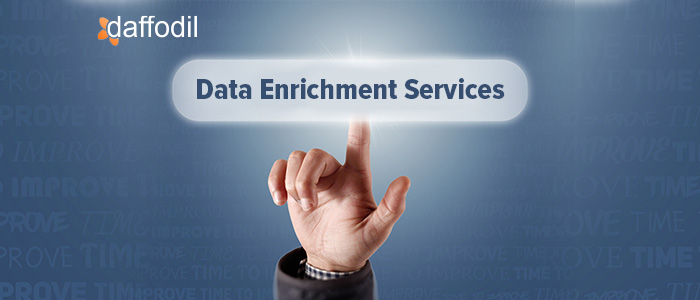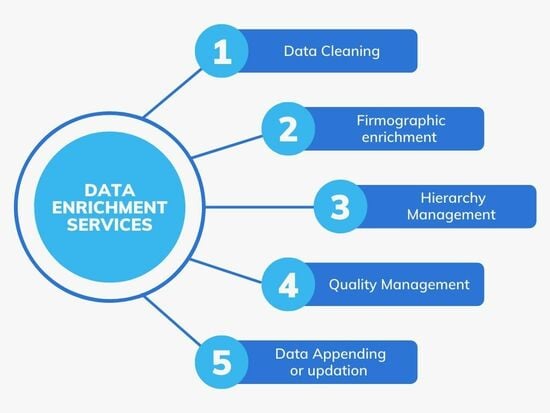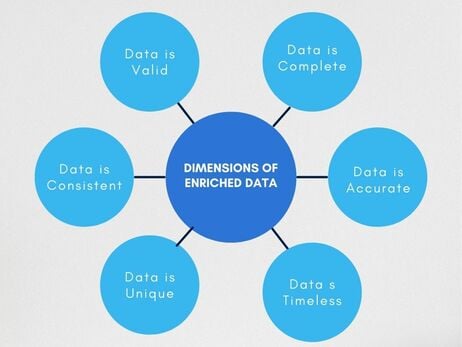
If you’re leading the marketing campaigns of an organization, you could relate to this! The prospect data received from website forms, surveys, web browsing, a list of event attendees, or advertising is not enough to create opportunities and convert a lead.
The B2B lead cycle is complex. The marketing and sales team struggle with insufficient data to analyze, strategize and prioritize prospects. This leads to missed opportunities, a low conversion rate, and incomplete targets.
The marketing and sales team needed a solution to create rich data to work around this scenario. That’s where data enrichment comes into the picture.
In the upcoming segment, we will discuss data enrichment services in detail- what it is, why it is needed, what services it includes, and what’s the approach to enriching data. Let’s get started.
What is data enrichment and why does it matter?
Data enrichment is the process of creating comprehensive and meaningful data by appending or enhancing the existing data with relevant context obtained from additional sources. This gives the inside sales rep an enriched view of the lead and improves the decision-making, collaboration, and tactical execution of the marketing team. In addition to this, enriching data offers the following benefits:
Data enrichment complete leads from varied sources
Data enrichment services help to maximize the outcome from existing data by adding relevant information to it. It extends and completes the data that’s received from varied resources- website, sales CRM, webinars, events, etc. Data from these sources are incomplete (in most situations) and to make it useful, enriching it with new data points is the key. This practice, called data enrichment fills the missing fields in the data set so that every lead brings an equal chance to create opportunities and conversion.
Data enrichment aligns marketing & sales together
Marketing focuses on leads and sales on conversion.
The marketing team tries to get the lead information with a minimum set of data fields. On the other hand, the sales team needs more details like the number of employees, contact details, company’s headquarters to figure out which sales rep to route that lead to.
Once the lead is captured by the marketing team, data updation can be done to add more information against a data field. This ensures that the two departments work hand-in-hand and the lead flows seamlessly throughout the funnel.
Data enrichment improves the lead qualification
Automating the inbound lead lifecycle- segmenting, prioritizing, and assigning is important to save time and effort. This is possible only when complete lead information is available.
Data quality management ensures that the right information is added to the existing data set along with the following benefits:
- It checks out for duplicate contacts in the database
- It helps to maintain a hierarchy of positions in a company
- It categorizes companies (geographic area, industry, technologies, etc.)
- It verifies that the data is qualitative and correct
This detailed information helps to verify if the lead is an ideal prospect or buyer of an organization's services. Lead qualification in such scenarios becomes simple, ultimately reducing the lead cycle.
Data enrichment shortens lead forms for marketers
The struggle to keep the lead forms short is real. If the form is too short, it will miss relevant information. And if it is too long, the prospects may not be interested to fill it out.
Therefore, a form must be short with the relevant set of information that makes progressive profiling possible. Once the fundamental fields are there, data enrichment services will improve the data by updating it with accurate, appropriate information.
What is the process for data enrichment?
Data enrichment services can be categorized into two categories:
- Lead Enrichment
- Account Enrichment
In both cases, the idea is to append or update the data but the use cases for the resultant data vary. Let’s understand with an example:
For a large number of leads coming in, it is important to prioritize, score, and route them. In this scenario, consider that your business targets multi-national corporations. Thus, it is essential to figure out the region to be targeted. Segmentation has a role to play here.
Lead enrichment has the following use uses:
Segmentation for marketing nurtures: In a lead lifecycle, a prospect is engaged multiple times through a variety of channels. A poorly targeted advertisement, email, or communication model can impact user experience and impact ROI in terms of cost, performance, and end-user experience.
Segmentation for event invites: There is no point in inviting people to events that they can’t attend. Segmenting attendees based on time zones, region, positions, etc. is important to ensure that the right event invites are sent to have maximum engagement.
Account enrichment is a data appending process at the contact level. This includes firmographics, employee count, technographic, etc. which helps to have a better understanding of the targetted businesses.
Account enrichment has the following use cases:
Improved follow-ups for leads: When data is augmented with more attributes, it allows the marketing teams to have meaningful communication with the prospects. For example, only the organization name, number of employees, and type of company were available when interaction was initiated. However, when the data got augmented, there were more details for better communication. Examples, the role of the point of contact, technology that the company deals with, product names, financial information, etc.
Know the market better: With data quality management and augmentation, marketing teams have the opportunity to understand the market, and requirements of different businesses by region, technology, scale, etc. This information helps to cognitively improve and make better decisions in the future.
A data enrichment services provider generally asks for preferences to improve the data. Here are some of the ways that are used to enrich the data.

- Data Cleaning: Also known as data cleansing services or data scrubbing, this technique of data enrichment involves modifying or removing data that are inaccurate, or outdated within the dataset.
This service is preferred by businesses that have a huge CRM database. This data, with time, gets outdated and incorrect, which therefore needs CRM cleansing services to reutilize it for new marketing campaigns. Clearout, through its Form Guard feature, strengthens CRM hygiene by validating contact details in real time at lead capture forms, reducing errors, blocking fake signups, and preventing inaccurate or outdated data from entering the database.
- Firmographic Enrichment: This involves data updation with organization-level attributes & characteristics such as industry, location, size, performance, financial status, etc.
- Hierarchy Management: This idea of enriching data involves updating the data with the leadership structure of the targetted business. For example, adding ranks, and positions (CxO, VPs, Senior associates, etc.) of the point of contact.
- Data Quality Management: This practice ensures that all relevant information that’s needed by an organization is added to the dataset. The data enrichment services provider takes the responsibility to look after the quality of overall data.
What are the various dimensions of enriched data?
Before enrichment, the data can be inaccurate, duplicated, inconsistent, or incomplete. Or there can be scenarios where there is too much data and that’s not needed.
How to determine that the data received after cleansing, appending, or updating is enriched?
There are six core dimensions (or characteristics) of an enriched data:

Data Completeness: All entities in the data set should be described properly.
Data Accuracy: The data should match the facts about it in the real world.
Timeliness: This refers to how up-to-date the data is.
Uniqueness: There should be no duplication or overlaps.
Consistency: When a data set moves from one location to another, the content remains the same.
Validity: How accurately the data is doing what it should be doing.
How often should you enrich your data?
In a medium or large-size organization, a substantial amount of data gets outdated every year. That is why it is essential to continuously monitor and update data with the correct and recent information.
The question is- how frequently should a business update its CRM data? At what pace should outdated data be checked and updated?
The answer to this question varies from business to business. If you are a large organization that collects data at a fast rate, then it is important to cleanse and update it more than a small or medium-sized business.
When you opt for experienced data quality management services, they keep a track of the data collected daily or monthly, and based on the analysis, they continue to perform data cleaning or append it with the right set of information.
Automated vs manual approach to data enrichment- Which one is effective and why?
Now that we know the benefits of data enrichment for a business, it’s time to get started with it. But how?
To cleanse, update, and maintain the quality of data, there are two competent approaches available:
a) Automated data enrichment tools
b) Manual data appending and cleansing
Which one is result-oriented, accurate, and fast- you may ask! Let’s discuss the two and figure them out.
Option 1:
Data enrichment tools are software application that looks at the contacts in a prospects list or a CRM and then updates them with missing fields. For example, if the marketing team needs to reach out to CEOs of selected companies but doesn’t have their contact information, data enrichment tools will populate the record with needed information.
But, how accurate this data would be? These tools merge the data from multiple sources using a third-party database as a starting point.
Moreover, when it comes to maintaining data, it’s not just about updating it. At times, the data might need to be cleansed (by removing outdated fields) or only specific fields need to be updated.
Unfortunately, no one tool fits all the requirements. For different business requirements, a custom solution would be required, which might prove feasible in terms of cost, management, and performance.
Option 2:
The manual approach to data enrichment involves cleansing, updating, enriching, and maintaining the CRM data, as per the requirement.
As compared to the automated data enrichment tools, the manual approach to identifying missing details, removing outdated records, and adding specific fields to the dataset is more proficient and cost-effective.
One of the most crucial advantages of manual data enrichment services is that it goes beyond the one-step research process and dives deep into various resources to get the required information.
Customization is the key benefit of manual CRM enrichment services. You can opt for any of the services and pay accordingly, rather than investing in multiple tools and paying the recurring costs for them.
The decision to choose between the two depends completely upon a business and its call for accuracy, completeness, and consistency. Amongst the two approaches available to enrich existing CRM data, the manual is certainly the most reliable one. But again, the choice depends upon the type of service required and the quality dimension of the data.
Conclusion
Ask yourself the following questions:
- Does your business have large data sets in CRM that have never been updated or enriched?
- Does that outdated data minimize the ROI of your marketing campaigns?
- Does the sales team confront issues in taking leads to the next level?
- Is your business’s sales cycle effecting due to incomplete data?
- Do you think that it’s time to cleanse and update your data?
If yes, then connect with us. Our data enrichment services are all your business needs to drive your marketing and sales efforts.




